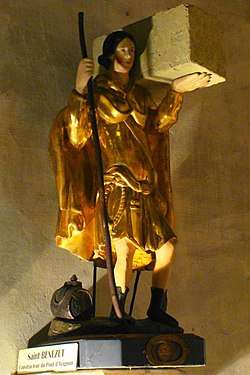Bénézet
Saint Bénézet[1] (Benedict, Benezet, Benet, Benoît, the Bridge-Builder), (ca. 1163–1184) is a saint of the Catholic Church, considered the founder of the Bridge-Building Brotherhood. Christian tradition states that he was a shepherd boy who saw a vision during an eclipse in 1177. This told him to build a bridge over the Rhône River at Avignon.
Saint Bénézet | |
|---|---|
 The statue of St Bénézet in Notre Dame des Doms in Avignon | |
| Born | c. 1163 Hermillon, Savoy, France |
| Died | 1184 |
| Venerated in | Roman Catholic Church |
| Feast | April 14 |
| Attributes | portrayed as a boy carrying a large stone on his shoulder |
| Patronage | Avignon; bachelors; bridge-builders |
He was told that angels would watch over his flocks in his absence. He built the bridge single-handedly; ecclesiastical and civil authorities refused to help him. Bénézet, it is said, lifted a huge stone into place, and announced it would be the start of the foundation. This would become the Pont Saint-Bénézet.
According to the legend, there were shouts of "Miracle! Miracle!" when Bénézet had laid the first stone. Eighteen miracles occurred in total: the blind had their vision restored, the deaf could hear again, cripples could walk; and hunchbacks had their backs straightened.
Bénézet thus won support for his project from wealthy sponsors who formed themselves into a Bridge Brotherhood to fund its construction.
Veneration
After his death, Bénézet was interred on the bridge itself, in a small chapel dedicated to Saint Nicholas, patron saint of mariners, standing on one of the bridge's surviving piers on the Avignon side. His relics were enshrined there until 1669, when a flood washed away part of the bridge. His coffin, recovered, was opened and the body of Bénézet was found to be incorrupt. The relics were translated to Avignon cathedral and thence to the Celestine church of Saint Didier. The remains of the bridge still remain a pilgrimage site.[2]
See also
- List of Catholic saints
- The Incorruptibles, a list of Catholic saints and beati whose bodies are reported to be incorrupt; that is, the bodies did not undergo any major decay after their burial and hence are considered to be under some form of divine protection.